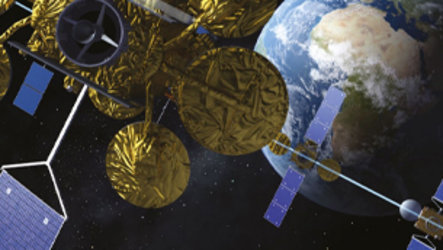Revision of DVB-RCS Standard Initiated
The DVB (Digital Video Broadcast) Project has initiated a major revision of the DVB - Return Channel Satellite (DVB-RCS) standard.
The Telecommunications and Integrated Applications (TIA) Directorate in collaboration with the Technical and Quality Management (TEC) Directorate of ESA is supporting this process through SatLabs, internal research and development activities, and ARTES industrial activities. Thanks to this effort, European industry is in the best position to contribute to the standard development and get most of its future benefits.
DVB has mandated its technical module to develop the commercial requirements for a Next Generation RCS (RCS-NG) A Call for Technologies has just been published by DVB. It is expected that the first specifications, covering the most widespread star network configuration for fixed terminals, will be agreed by the end of 2009. These specifications shall include improvements in the following areas:
- Channel coding and modulation formats
- IP traffic encapsulation and framing
- Access protocols
- Internetworking and management
In October 2008, the DVB Project approved the commercial requirements for RCS-NG. These requirements were prepared by the DVB CM-RCS (Commercial Module - RCS) subgroup, which was formed in April 2008 to evaluate the potential market for such next generation. This grew out of work that had been carried out by Satlabs during the previous months, which suggested a revision to the standard was timely and worth pursuing. To date, support for the RCS-NG initiative has come from 20 organisations.
DVB-RCS is the only multi-vendor VSAT (Very Small Aperture Terminal) standard. It was conceived to provide a standardised broadband interactivity connection as an extension of the DVB satellite systems. It defines the air interface waveform and protocols used between the satellite operator hub and the interactive user terminals. It embraces the DVB-S and the DVB-S2 standards implemented in the commercial broadcasting environment, exploiting its economics of scale.
Low cost VSAT equipment can provide highly dynamic, demand-assigned transmission capacity to residential and commercial/institutional users. DVB-RCS provides users with the equivalent of an ADSL or cable Internet connection, without the need for local terrestrial infrastructure. Depending on satellite link budgets and other system design parameters, DVB-RCS implementations can dynamically provide in excess of 20 Mbit/s to each terminal on the outbound link, and up to 5 Mbit/s or more from each terminal on the inbound link. The standard was first published by ETSI in 2000 as EN 301 790.
By mid-2008, DVB-RCS has been deployed over more than 200 networks worldwide, serving more than 80,000 remote terminals. In 2008 the specifications were extended by DVB to cover mobile terminals (a.k.a. RCS+M or revision 1.5.1 of the standard). The SatLabs Group developed the Certification program for DVB-RCS products. This had led to the certification of nine terminal types from six manufacturers so far.
The large market for broadband VSAT services, particularly to consumers, is finally taking off as demonstrated by Astra2Connect and TooWay developments in Europe as well as Wildblue and Hughes Network Systems' SpaceWay in the U.S. The deployment of high capacity, transparent and regenerative multi-beam satellites allows for a more cost effective use of interactive satellite networks, as required for the consumer user segment.
Subsequently, this increases the competitiveness of satellite networks with respect to terrestrial technologies. Many such systems, mostly in Ka band, have recently been deployed (Wildblue, SpaceWay) or will be operational in the next few years (HylasOne, KaSat).
From shipments of fewer than 300 000 terminals per annum in 2004, the VSAT market reached 750 000 shipped terminals in 2007 (source: Comsys). This evolution of scale has led to a dramatic decrease of VSAT unit price. Although benefits of large scale are also increasing for DVB-RCS systems; 2006 and 2007 saw a significant increase of DVB-RCS equipment sales and compliant solutions are approaching price/performance competitiveness with proprietary VSAT solutions in sufficient volume; further improvements are required.
The industry recognises that RCS still has a modest market footprint in many market sectors and that RCS-NG must be relevant to current and future market needs. It is clear that it needs to compete in the now proven consumer market, but at the same time must be able to offer variants that are state-of-the-art in the corporate, backhaul, military, mobile and mesh arenas. It is expected that the benefits derived from the large scale of the former market and the features that are required to compete in it will flow into the other market sectors and benefit all users of the new standard.
For more information regarding the Call For Technologies and DVB, visit the links located in the top right column of this page.















 Germany
Germany
 Austria
Austria
 Belgium
Belgium
 Denmark
Denmark
 Spain
Spain
 Estonia
Estonia
 Finland
Finland
 France
France
 Greece
Greece
 Hungary
Hungary
 Ireland
Ireland
 Italy
Italy
 Luxembourg
Luxembourg
 Norway
Norway
 The Netherlands
The Netherlands
 Poland
Poland
 Portugal
Portugal
 Czechia
Czechia
 Romania
Romania
 United Kingdom
United Kingdom
 Slovenia
Slovenia
 Sweden
Sweden
 Switzerland
Switzerland



























